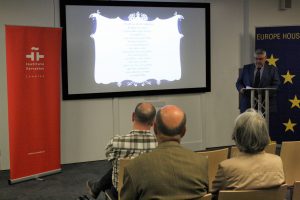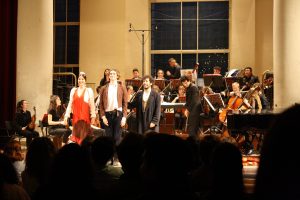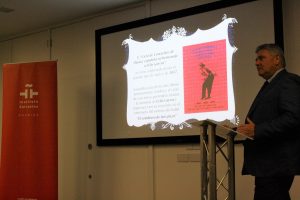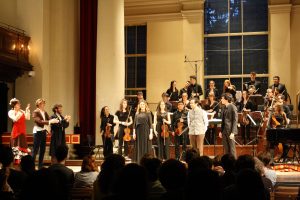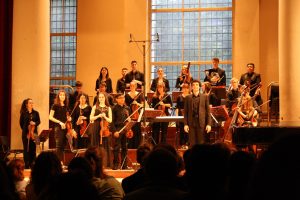La historia oculta de ‘El Sombrero de Tres Picos’ de Manuel de Falla, al descubierto en Londres
A punto de cumplirse el centenario del estreno del ballet ‘El sombrero de tres picos’ (julio de 1919), el escritor, músico y docente Antonio Hernández Moreno presentó las investigaciones, realizadas en las dos últimas décadas, en una conferencia organizada por el Instituto Cervantes de Londres, que revelan que casi un tercio de la partitura de El sombrero de tres picos de Manuel de Falla fue compuesta y orquestada por los compositores Maurice Ravel y Ottorino Respighi.
Hernández Moreno encontró en la Houghton Library (Universidad de Harvard) una desconocida partitura manuscrita de la música completa del ballet en versión para piano bajo el título ‘Le Chapeau tricorne’. La investigación demuestra, una vez analizadas las características caligráficas y las modificaciones que sufrió la obra original que Falla compuso bajo el título de ‘El Corregidor y la molinera’, que Ravel y Respighi arreglaron, terminaron y orquestaron la obra que daría lugar a la partitura definitiva del ballet ‘El sombrero de tres picos.’
En junio de 1916, el empresario ruso Sergei Diaghilev (en agradecimiento a las ayudas recibidas por Alfonso XIII en la liberación de Nijinsky de un campo de concentración al inicio de la Guerra Mundial) acuerda en Madrid con el dramaturgo Gregorio Martínez Sierra adaptar la novela de Pedro Antonio de Alarcón ‘El sombrero de tres picos’, para la creación de un ballet español que interpretarían los Ballets Russes. Manuel de Falla fue el compositor elegido por Diaghilev.
Después de un primer intento de estrenar la obra en Roma a principios de 1917 con ‘bailaores’ españoles, y tras un grave desencuentro con Nijinsky – ya liberado y en España– para que la estrenara junto a Pastora Imperio, Diaghilev contrata finalmente al joven y brillante bailarín español Félix García, para enseñar los ritmos españoles a los miembros de la compañía y protagonizar además dicho ballet. Félix García, además de músico, era un ‘bolero’ (nombre que recibía un bailarín experto en bailes del país), y no un ‘bailaor’ flamenco de origen andaluz como se creía.
Por entonces, la compañía de los Ballets Russes se encontraba estancada en España a causa de la Guerra Mundial, así que tras actuar en Lisboa y realizar un gira por varias ciudades de España, y casi disolverse, Diaghilev consigue liberarla del bloqueo gracias una vez más a las gestiones diplomáticas de Alfonso XIII, lo que le permite a Diaghilev y su compañía viajar finalmente a Londres en agosto de 1918.
Tras una larga temporada de actuaciones en el Coliseum Theatre, la compañía pasa al Alhambra Theatre, donde Diaghilev ya tiene previsto estrenar ‘El Corregidor y la molinera’ junto a otros ballets de carácter español. Pero nuevos contratiempos y retrasos, entre ellos la terminación de la partitura definitiva del ballet por parte de Falla, provocó que Diaghilev contratara en secreto a los compositores Ravel y Respighi para que la terminaran. La sustitución de Félix y Sokolova en los papeles principales, y el ingreso del bailarín español en un sanatorio mental no impidió que el ballet, ya con el nuevo título de “El sombrero de tres picos” se estrenara ‘in extremis’ el último día de actuación. Picasso diseñó los decorados y el vestuario, realizando un dibujo a lápiz de Félix y Sokolova durante un ensayo, única imagen que se conserva hasta ahora del bailarín español.
Hernández Moreno que establece también un paralelismo entre lo sucedido a Félix García y el destino final del legendario bailarín ruso Vaslav Nijinsky. La investigación concluye además que el conocido ‘Bolero’ de Ravel fue motivado y dedicado en secreto al propio Félix.
Los resultados de esta investigación han sido publicados de forma novelada en el libro ‘Treinta castañuelas para Londres’ que saldrá a la venta en las próximas semanas.
The hidden story of ‘The three-cornered hat’ by Spanish composer Manuel de Falla
On the occasion today of the centenary of the premiere of the ballet ‘The Three-cornered Hat’ (22nd July 1919), the research, carried out in the last two decades by the Spanish writer, musician and teacher Antonio Hernández Moreno, reveals that almost a third of the ballet score by Manuel de Falla was composed and orchestrated by composers Maurice Ravel and Ottorino Respighi.
The researcher made this information public at a lecture hosted by the Instituto Cervantes in London, hosted at the Europe House. The writer found in the Houghton Library (Harvard University) an unknown manuscript score of the ballet complete music on piano version under the title ‘Le Chapeau tricorne’. The study demonstrates, once analysed the calligraphic features and modifications made on the previous work composed by Falla under the title of ‘The Governor and the miller’s wife’, that Ravel and Respighi arranged, finished and orchestrated the work that would become the final score of the ballet ‘The Three-cornered hat.’
In June 1916, the Russian impresario Sergei Diaghilev (in gratitude for the aid received by King Alfonso XIII in the release of Nijinsky from a concentration camp at the beginning of the World War) agreed in Madrid with the playwright Gregorio Martínez Sierra to adapt the famous novel by Pedro Antonio de Alarcón, into a plot for a Spanish ballet to be premiered by the Ballets Russes. Manuel de Falla was the chosen composer by Diaghilev.
After a first failure attempt to premiere the ballet in Rome at the beginning of 1917 with Spanish ‘bailaores’, and after a serious disagreement with Nijinsky – already released and in Spain- to be represented with Pastora Imperio; Diaghilev finally hires the young and brilliant Spanish dancer Félix García, to teach the Spanish rhythms to the members of the company and also play the main role of the ballet. Felix Garcia, was not only a musician but also a very gifted ‘bolero’ or ‘bolerist’ (name given to a virtuoso dancer specialised in Spanish national dances), and not an Andalusian ‘bailaor’, as it was believed until now.
At that time, the Diaghilev’s Ballets Russes was stuck in Spain because of the World War, so after a rugged performances in Lisbon and a tour through some Spanish cities, and almost become dissolved, Diaghilev managed to release it from the blockade thanks once more to the diplomatic efforts made by King Alfonso XIII, which finally allow Diaghilev and his company to travel to London in August 1918.
After a long season at the Coliseum Theater in London, the company moves to the Alhambra Theater, where Diaghilev has already planned to premiere ‘The Governor the miller’s wife’ along with another Spanish character ballets. But new setbacks and delays, including the never finishing of the final ballet score by Falla, caused Diaghilev to secretly hire the composers Ravel and Respighi services to finish it. The replacement of Felix and Sokolova replacement in their main roles, and the confine of the Spanish dancer in a mental hospital did not prevent the ballet, now retitled ‘The Three-cornered Hat’ was premiered ‘in extremis’ on the last day of the season performance. Picasso designed sets and costumes, making a pencil drawing of Felix and Sokolova during a rehearsal, the only surviving image of the Spanish dancer.
Hernandez-Moreno establishes as well a parallel between what happened to Felix Garcia and the final destiny of the legendary Russian dancer Vaslav Nijinsky. The research also concludes that the orchestral masterwork ‘Bolero’ by Ravel was inspired, motivated and secretly dedicated to Felix. The results of this study have been published in a novelized way in the book ‘Thirty castanets for London’ that will be coming soon in weeks.
On the other hand Hernandez Moreno has promoted and managing a Spanish music and dance festival for three years in homage to Félix García, with the aim of honouring his memory and trying to erase the unfair nickname of ‘Felix the Mad’, maliciously or wrongful named for several decades.
The passage of Diaghilev’s Ballets Russes through Spain claimed two victims: Nijinsky, who lived the rest of his life among several mental sanatoriums in Switzerland; and Felix Garcia, who spent almost twenty years inmated and forgotten in a mental hospital in Epsom (England) until he died in 1941, where his rest remains in an abandoned cemetery.

